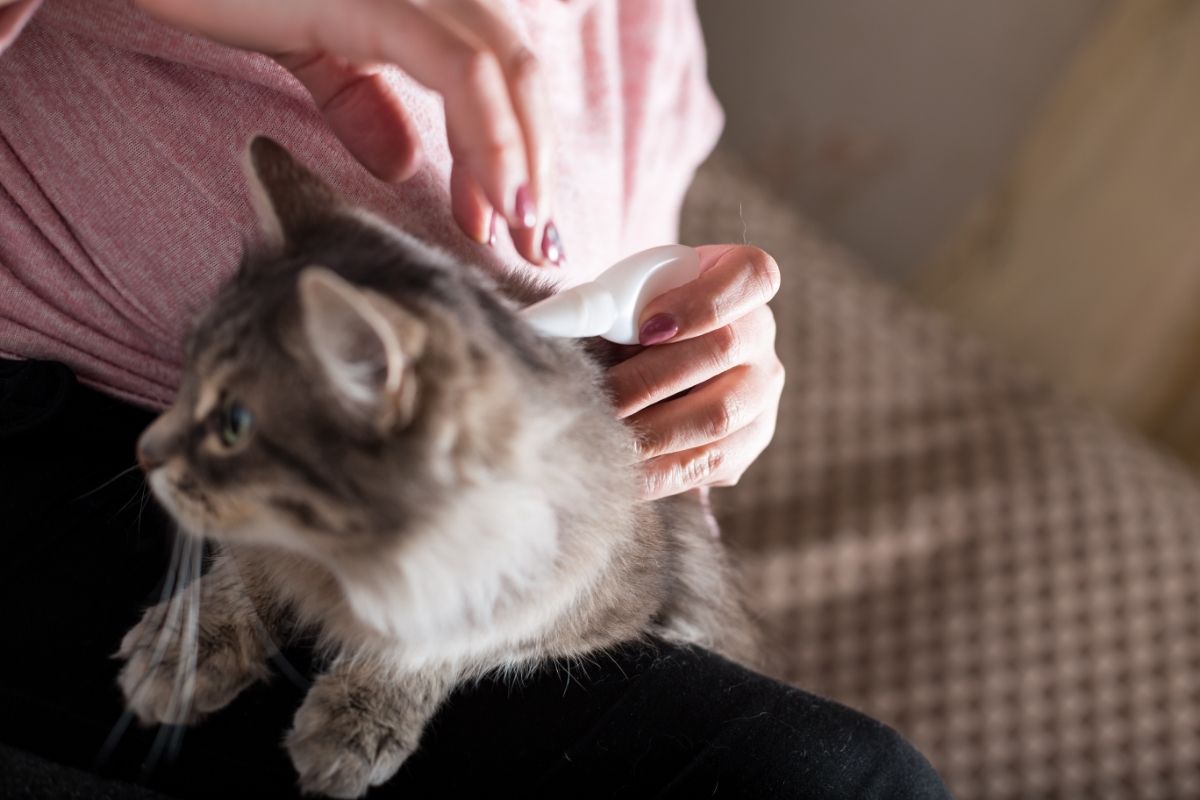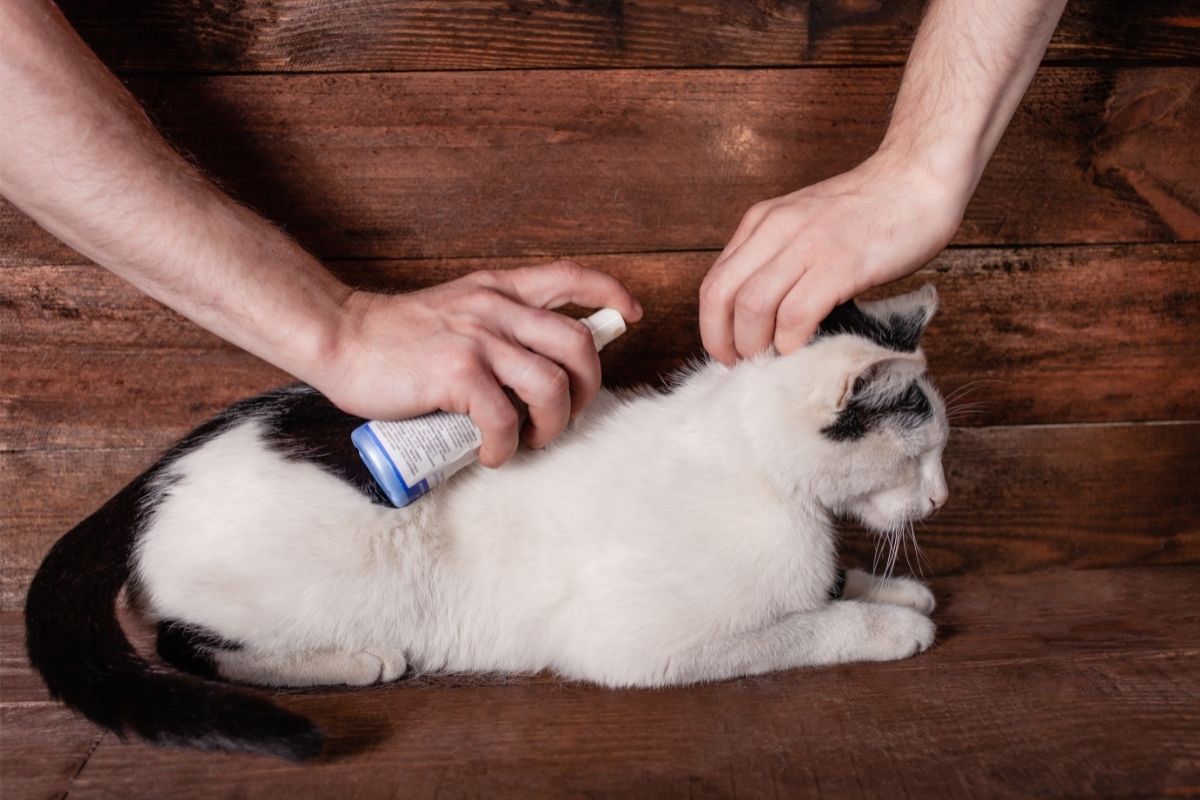If your cat has fleas, you are probably annoyed and frustrated. Cat fleas can also lead to your pet contracting tapeworm. This is why you need to know how to get rid of fleas on cats as soon as they are spotted.
Both dogs and cats are very susceptible to the bites of fleas. Cats can get fleas all year round, while dogs tend to see an increase in the summer months when they spend more time outside. Fleas can lead to skin conditions like dermatitis, pest bites, and burn.
Cats are especially susceptible due to their thin skin, which the mouthparts of a flea can easily penetrate. The feline temperament combined with the intense itchiness of a flea bite can cause stress and irritation.
Learn how to get rid of fleas on cats naturally and effectively by reading on to find out how to perform a flea check, flea treatment for cats, and prevent future infestations.
Let’s Meow!

Felines and Fleas Don’t Mix!
Felines and fleas just don’t mix! That is how it has always been, how it will always be. The very thought of dealing with fleas on cats sends shudders down the spine of every feline lover.
If your cat has been outside at all, there is a high chance that they have caught fleas. Indoor animals can also get fleas if another pet brings them home from the outdoors or if an infected stray cat sets up camp in your garden.
Fleas can jump 7 to 8 inches (17.78 to 20.32 centimeters) vertically and 13 inches (33.02 centimeters) horizontally, so it only takes one small jump from a passing cat or dog for your pet to catch them. Once you have fleas on your cat, they will quickly spread and multiply into hundreds of new adult fleas.
So, do you want to know how to get rid of fleas on cats fast? Let’s first learn how to perform a flea check on your cat.
How to Perform a Flea Check on Your Cat
Start your flea treatment for cats by checking whether they have fleas. Cats, just like us humans, can get very itchy if covered in them and will scratch themselves raw, which is extremely painful and uncomfortable for them. So give them a good hunt down to see if you can spot any of these pesky insects that drive your pet nuts!
Cat fleas are small, dark brown, and have a flattened body that allows them to move through the fur of your cat quickly. They tend to prefer black cats for this reason because you will find it easier to spot them on the coat.
They are also speedy movers, so make sure you are ready before carrying out your check. Have a flea comb ready to catch any you find, and ensure that you have some soap nearby in case your cat needs a good bath afterward.
Performing the check can be pretty tricky, especially if your cat does not like to stand still for any length of time. The best way is to try and get them when they are relaxed, so after they have eaten or when they are on the sofa with you.
Having someone to help you will also make things easier because one of you can keep petting your cat while the other does the check. If you work best alone, try to get them on their back first and then search for any signs of cat fleas. Read our article and find out how to get rid of fleas on dogs.
To perform a cat flea check, start in the middle of their back and use long strokes to search for any dark brown insects. Aim to check out the neck and shoulders first. Some cats will groom themselves while doing this, which is a sign that you are doing things right, so just carry on.
When you have reached the tail, lift it to check underneath and then search their legs. Cats tend to kick out with their back legs if you try to check both sides of them, so do one side at a time.
Once you have finished your inspection, place your cat back on the ground if they were on the sofa and check any surrounding furniture for bugs before picking them up again.
If you find fleas or flea eggs on cats, take the following steps to get rid of them.
How to Get Rid of Fleas on Cats
There are many ways to get rid of fleas on cats depending on whether you want a home remedy for fleas or need help from a veterinarian. This will depend on how bad the infestation is and what you have available to hand.
If your feline friend has a flea infestation, there are steps you can take to remedy the situation yourself. Here’s how to get rid of fleas on cats fast:
Step 1: Remove Fleas by Combing
You can use a fine-toothed flea comb, soap, and water to quickly remove fleas, flea larvae, or flea dirt on cats. You can also use a soft-bristled brush that will not hurt your cat’s skin. Use the flea comb to gently rub it through its coat and catch any bugs you find on the teeth of the comb.
Fleas are very good at hiding, so take your time with this step to ensure you don’t miss any out.
Step 2: Use a Flea Medication
After you have removed your cat’s fleas, you can use a flea medication to prevent further infestations. There are many on the market, each slightly different in terms of what it does and how long its effects last.
You must consult your vet before applying any kind of flea medication to your cat because some are toxic for them. If you use the correct one for your pet, however, cat fleas will be history in no time at all.
Some of the basic types of flea medication include:
- Spot-on treatments: These are liquid flea medications that you apply to the skin between your cat’s shoulder blades. Some can smell bad, and your cat may not like them. Sometimes, these medications can cause your cat to feel sick. If misused, they may leave stains on your cat’s fur and skin.
- Tablets: These are similar to the spot-on treatments, but you give them to your cats by mouth. They are straightforward and do not usually affect cats in the same way that spot-on treatments sometimes can.
- Flea and tick collars for cats: These are usually made of plastic and protect your cat’s neck area. The active ingredients in these collars are effective during the month of wear. Some cats will not like the sensation of having something around their neck, but it’s a good option if you want to prevent your cat from ingesting flea medication.
- Homes remedy for fleas: Several home remedies on cats use items that you can easily buy from your local store. Most of these are effective, but they are usually less potent than products that you can buy from your vet or pet store. Some of the most common ingredients in home remedies for fleas on cats include apple cider vinegar, dish soap, and Borax powder.
Step 3: Clean Your Cat’s Home
Cat fleas can also live in the carpets and furniture of your home. Thoroughly clean around where your cat lives to get rid of any eggs, larvae, or adults that may have taken up residence. Vacuum everywhere, from floorboards to skirting boards, wash curtains, and bedding with soapy water.

Getting Rid of Feline House Fleas
In general, it is best to consult your vet if you suspect that your cat has fleas, as they will be able to recommend the best course of action. They may want to do a skin scraping or blood test or take a sample from your cat’s fur to analyze what sort of flea is affecting them and how severe the problem is.
If you are confident that the flea problem is not too bad, however, then you can try any of the methods above to get rid of them yourself or contact your vet for advice on which topical cream would suit your cat best.
Once you’ve gotten rid of all your cat’s fleas and prevented new ones from taking hold, you should keep on top of things by brushing him regularly and not allowing him outside unless he has his flea prevention medication with him. If your cat goes out for walks, this can give its fur a nice sheen that is attractive to fleas!
How Do I Know if My Cat Has Fleas?
The most common sign that your cat has fleas is seeing tiny black or brown dots hopping around its fur. These are flea droppings, and if you have a significant infestation, you may be able to see them moving!
Another good indication of a flea problem in cats is the presence of tiny red bites on your cat’s skin. Again, these will be accompanied by black and brown specks if there are flea droppings.
Other symptoms of cat fleas include:
- Lots of scratching and chewing on its fur.
- A loss of hair where your cat has been scratching itself excessively.
- A greasy or matted coat makes the skin underneath darker than usual.
- Intense itching and discomfort.
The Repercussions of Untreated Cat Fleas
You may think that just because your cat doesn’t seem to be in much discomfort now, there’s no need to worry about what could happen if you don’t get rid of the fleas.
The truth is there are many ramifications of letting a cat suffer from an infestation of fleas. Some cats can go into anaphylactic shock if they get bitten too many times; this can be fatal.
Cat skin is very sensitive, and the constant scratching and itching that results from an infestation of fleas will strip away its protective layers. This leaves it vulnerable to infections, dehydration, sun damage, mange, and worst of all, abscesses – infection pockets underneath the skin.
Fleas can also carry tapeworm larvae which can make their way into your cat’s digestive system when it consumes them when cleaning itself. This causes symptoms such as vomiting and diarrhea but can lead to organ damage and even death if left untreated.
Preventing Fleas on Cats and Your Home
Prevention is the best method of getting rid of fleas on cats. After all, if you can stop your cat from catching them in the first place, then there’s no need to worry about how to get rid of fleas!
Flea control for cats generally gets done through topical creams or sprays applied to your cat’s fur. These create a protective barrier against fleas, stopping them from biting and laying their eggs in its coat.
The best time to use one of these treatments is when your cat is still a kitten, especially if you have other cats or animals at home. This is because they can become immune to the effects of the topical solution if it has been applied constantly and will no longer be as effective for them.
If you don’t catch fleas early, though, then it’s still possible to treat your cat with a product that will get rid of them as well as prevent new ones from appearing. The same thing goes for removing fleas from your cat’s environment by treating carpets, bedding, and other belongings.
If you are using an anti-flea treatment on your cat to get rid of the current infestation, there are some things that you should know:
- Always check the instructions on how frequently it should be applied, especially if your cat has particularly sensitive skin.
- If you are using a topical solution to get rid of fleas in cats, it’s best to use one designed for this purpose, rather than human flea treatment or something similar.
- Make sure you let your cat wear the treatment for at least two weeks to ensure there are no eggs left in their coat.
- If you don’t want to use a topical solution, a natural flea killer for cats as a repellent may be an alternative. The downside to this method is that it won’t kill the fleas at their source.
- Don’t use a natural repellent on kittens under 12 weeks old.
- You should always speak to your vet before using any product on your pet.

The Final Meow!
So now you know how to get rid of fleas on cats. If your pet has fleas, you must act quickly. The longer you leave it, the more cat fleas your pet will have and the harder it will be to fix.
Be sure to check with your vet before using any flea treatment for cats on your pet, especially if they are under 12 weeks old or have sensitive skin. Don’t forget that flea removal is only part of the process; you also need to make sure that your home is free of fleas as well!
Don’t hesitate to contact your local vet. They should be able to recommend an alternative solution. If your pet has a question, you have the answer! Have a meowtastic day and a fantastic life!


1 thought on “How To Get Rid Of Fleas On Cats”
Comments are closed.